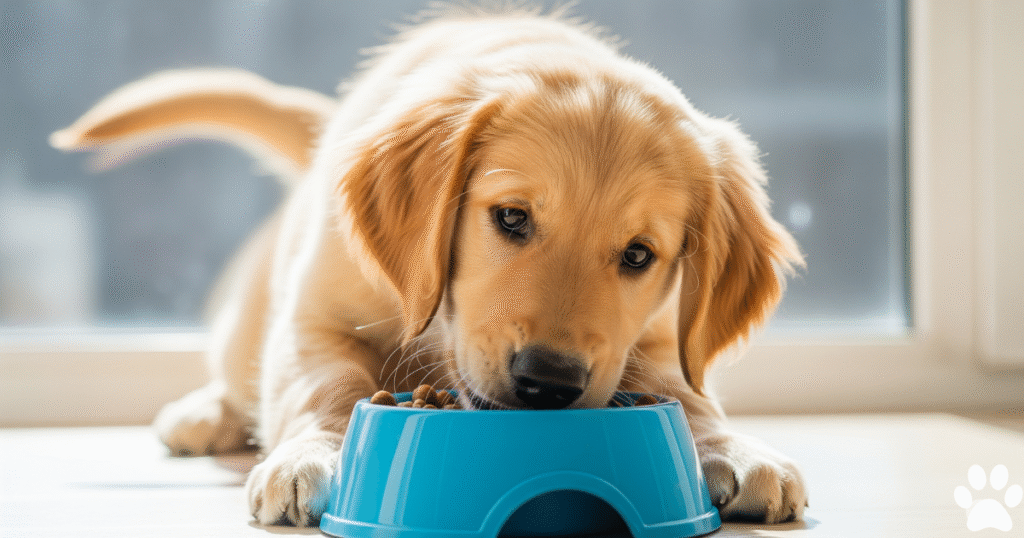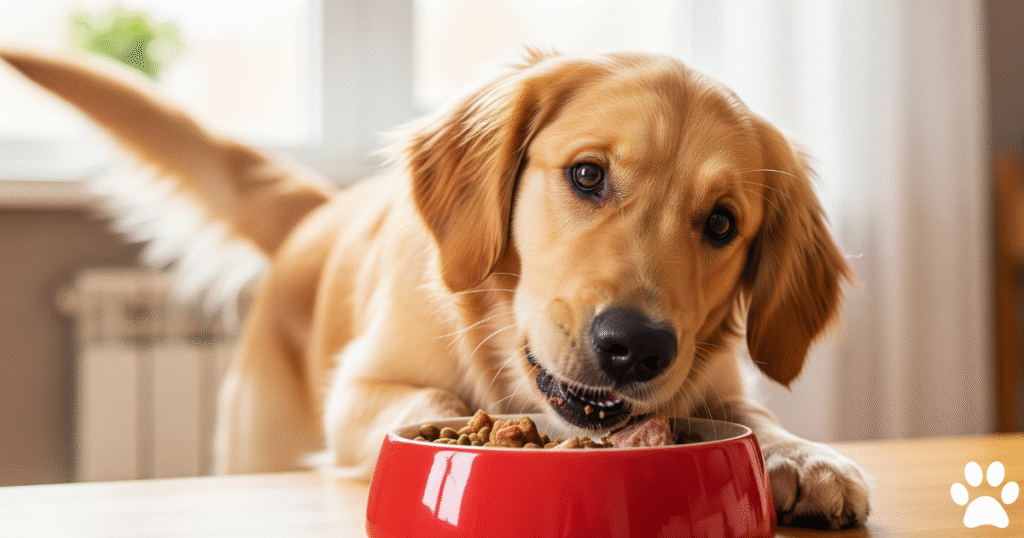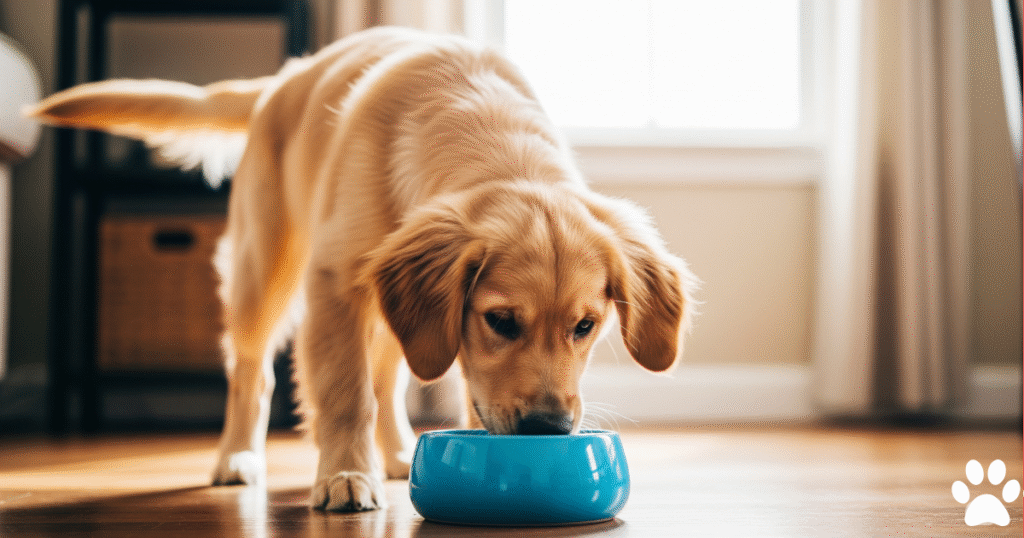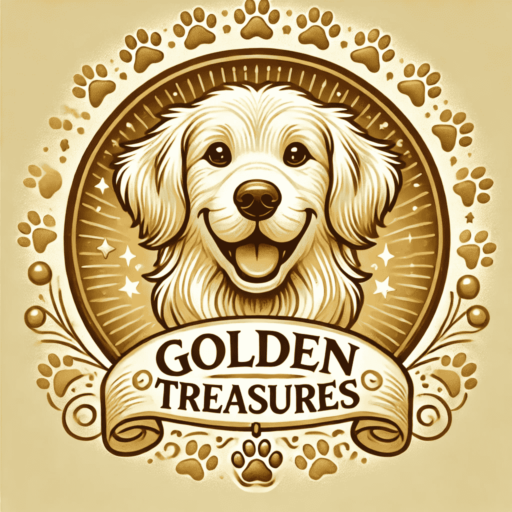Golden Retrievers are the most popular dog breed worldwide. In fact, year after year, they consistently top the list. They are extremely affectionate and playful pets who love to jump in the pool or lie on the couch with you. Due to their calm and energetic behavior, they are easy to train, making them great working dogs and loyal companions. If you’ve decided to add a Goldie to your family, you’ll probably also know that these dogs have a reputation for being very picky eaters. They may want to eat everything you put in their food bowl, and maybe even what he doesn’t eat on their plate.
When creating a Golden Retriever Food plan, it’s important to find the right balance between quality, quantity, and nutritional value of food. A proper Golden Retriever Food plan ensures that your puppy gets all the essential nutrients to grow healthy and strong. When creating a Golden Retriever meal plan, it’s important to find the right balance between quality, quantity, and nutritional value of food. In this Golden Retriever Food Guide blog, you’ll find everything you need to know about your puppy’s feeding options and the best Golden Retriever Food choices.
Contents
- 1 Factors to consider for creating Golden Retriever Food:
- 2 Feeding Guidelines Golden Retriever:
- 3 Feeding Guidelines Golden Retriever:
- 4 How Much Food Should an Adult Golden Retriever Eat?
- 5 How Many Treats Should You Give a Golden Retriever?
- 6 Hypro Premium for Adult Dogs:
- 7 Ingredients to Include in a Golden Retriever’s Diet:
- 8 Conclusion:
Factors to consider for creating Golden Retriever Food:
| Factor | Puppy (0-1 year) | Adult (1-7 years) | Senior (7+ years) |
| Nutritional Needs | High protein and fat to support growth | Balanced protein for maintenance, moderate fat | Lower fat, high fiber for digestion |
| Calories | Higher caloric intake due to growth | Moderate caloric intake based on activity | Reduced calories to manage weight |
| Activity Level | Highly active, requires more calories | Variable; adjust based on activity level | Generally, less active; adjust intake accordingly |
| Meals per Day | 3-4 meals to prevent hypoglycemia | 2 meals per day | 2 meals per day with possible snacks |
| Ingredients | Puppy-formulated kibble with DHA, and omega fatty acids | Whole meats, whole grains, and veggies | Senior-specific kibble with glucosamine |
| Hydration | Ensure constant access to fresh water | Fresh water available at all times | Monitor hydration levels; consider moisture in food |
| Supplements | Generally, not needed if on a complete puppy diet | May require joint support supplements | Joint and vitamin supplements often recommended |

Feeding Guidelines Golden Retriever:
| Age Group | Gender | Weight Range | Height Range |
| Puppy (0-1 year) | Male | 20–45 pounds (varies) | 10–18 inches (varies) |
| Female | 20–45 pounds (varies) | 10–18 inches (varies) | |
| Adult (1-7 years) | Male | 66–75 pounds | 22–24 inches |
| Female | 60–75 pounds | 22 inches tall | |
| Senior (7+ years) | Male | 60–75 pounds | 22–24 inches |
| Female | 55–75 pounds | 22 inches tall |
Feeding Guidelines Golden Retriever:
Milk is one of the best foods for puppies. In most cases, your breeder will feed your dog milk. It is recommended that Golden Retrievers be adopted when they are at least eight weeks old. However, if you need to wean your Golden Retriever puppy, you can start weaning as early as 3 weeks of age with your veterinarian’s approval. If you want to wean your puppy, you can mix some dry food with puppy milk to make a paste at first. You can feed this mixture to your puppy up to four times a day, gradually reducing the amount of milk. Over time, your puppy will become accustomed to solid food and will eventually no longer need to add milk to his diet.
The exact amount of food you feed your puppy will depend on the type of food you are feeding him. Different types of food have different calorie levels. So check out the brand’s nutrition guide to make sure you’re getting enough nutrients.
While chubby puppies are cute, your Goldie won’t gain much weight if you feed him solid food.
4 months – 10 months
Golden Retrievers are a large breed, which means they’ve grown quite a bit by the time they’re a year old. A Golden Retriever grows from a 4-pound puppy at 7 weeks to an adult dog weighing nearly 30 pounds in just 10 months. At six months, your puppy is still growing, albeit at a slower rate, reaching most of his physical developmental milestones. So proper nutrition during the first year of life is critical to your Goldie’s overall health in the years to come.

10 months – 12 months
A one-year-old Golden Retriever weighs around 30 pounds. They still have some growing to do, but this will vary depending on your dog. Some Goldies experience a growth spurt around their second birthday, while others stay the same size.
As a Goldie owner, you should monitor your dog closely and adjust their diet to accommodate their continued growth.
It is extremely important to avoid overfeeding during this time. Large breeds are at risk of growing too quickly, making them more susceptible to skeletal and weight problems as they age. Golden Retrievers are especially susceptible to hip and elbow dysplasia. This can be avoided with proper nutrition.

What to Feed Golden Retriever Puppies:
Adult dogs and puppies have different nutritional needs. This should be taken into account when creating a Golden Retriever puppy feeding plan.
Puppies require more calories than adult dogs due to their rapid growth. However, they have much smaller stomachs, meaning they become full faster. This can lead to puppies, especially Golden Retrievers, easily overeating. You can prevent your puppy from overeating by giving him a short time to eat and then removing his food bowl. All puppies grow quickly in their first year of life, but large breed puppies are at greater risk for adverse health effects. To provide your Golden Retriever puppy with optimal nutrition for his rapid growth, you should consider choosing a large breed puppy food. Goldie puppies need plenty of protein, fiber, and fatty acids to support their development and provide energy. This diet also takes into account the differences in nutrient absorption between small and large breeds. Nutrients like calcium and phosphorus are beneficial for all dogs, but an imbalance of these nutrients can increase the risk of abnormal skeletal development in large breed puppies.
How Much Food Should an Adult Golden Retriever Eat?
An adult Golden Retriever needs about 1,400 to 1,500 calories per day. The amount of food you feed your dog is determined by several important factors. On average, a male Golden Retriever will need slightly more food than a female, depending on his weight. Your Golden Retriever’s reproductive status, whether he is spayed or neutered, also plays a role in his calorie needs. Some older dogs are less active and may therefore need fewer calories. Daily nutritional requirements vary greatly, especially among goldfish. If you are unsure how much food your Goldie needs, it is best to consult with your veterinarian.
Regardless of the amount of food, it is best to feed your dog twice a day. Feeding your dog twice a day, in the morning and in the evening, will help establish a routine and avoid overfeeding. This routine can include exercise and encourage healthy eating and toilet training.

Special Considerations:
Your Golden Retriever may be prone to a variety of health problems. These are important to consider when making decisions about their diet. Golden Retrievers are known for their beautiful coats, but their skin is often prone to infections. Goldfish love to swim, but they can cause problems if they swim in water that contains parasites. They can also be prone to atopic dermatitis, which causes intense itching. Dogs then lick and bite, which can cause even more damage. For dogs prone to skin and coat problems, a fish-based diet may be beneficial. Fish contains many fatty acids that promote healthy coats and skin. Remember to always consult with your veterinarian before making any significant changes to your dog’s diet.
Best Food for Golden Retrievers:
When it comes to feeding your Golden Retriever, you have many options. Here are the pros and cons of three of the most popular options: wet food, raw food, and dry food. Wet food can be a good option for dogs that require a lot of protein and fat, such as working dogs or dogs with certain health issues. It also ensures that your dog gets enough fluids during meals, which can be helpful for sick dogs. However, once opened, it does not last long. Once opened, consume within one to two days.
For dogs with a very limited diet, homemade raw food can be a great way to get involved in preparing your dog’s food. You have complete control over a raw food diet. While it will require more effort on your part, it can also yield great results. For example, a Golden Retriever with heart problems should be on a low-salt diet. This will be easier to achieve if you prepare the food yourself. Dry dog poop is usually the easiest solution for you as a dog owner, as it stays where it is and does not create a mess. It can also be good for your Goldie’s teeth. Whatever option you choose for your Goldie, make sure it is suitable for large breeds and contains high-quality ingredients. Try adding grains to your dog’s food to provide complete nutrition and plenty of energy.
How to Keep Your Golden Retriever Healthy and Fit:
Your Golden Retriever needs the right balance of exercise and nutrition to stay fit and healthy throughout its life. The first step is to make sure your dog’s food contains the nutrients it needs at each stage of life, from puppyhood to old age. This can prevent long-term degenerative health problems. Your Goldie’s nutritional needs will change as it gets older and becomes more lethargic. By monitoring your dog’s eating habits, you can determine when adjustments to its diet are needed. Watching your dog’s behavior while eating can also help you spot early signs of illness or stress. Your Golden Retriever loves to eat and will likely try to eat anything you put in front of it. Therefore, you need to help him avoid the negative consequences of overeating. Also, make sure that your dog does not eat foods that can be harmful to his health. Like other large active breeds, Golden Retrievers need a lot of exercise. This is important not only for their physical health, but also to ensure that they are well socialized and mentally stimulated.
| Age | Feeding Frequency (times a day) |
| Under 8 weeks | 3 – 4 |
| 8 weeks – 11 months | 3 |
| Over 11 months | 2 |
By following a consistent feeding schedule, you can control your dog’s eating behavior. Golden Retrievers love to eat, but this appetite can be accompanied by less social eating behaviors, such as alertness and aggression. This plan will help you and your dog can prevent these reactions through training. You can also schedule exercise and toilet breaks during mealtimes. You can easily adjust your dog’s feeding schedule to fit your schedule. If you feed your dog before a morning or evening walk, make sure that it has enough time to properly digest the food. Also, make sure that your child has enough time after dinner to burn off all the energy before bed.
How Many Treats Should You Give a Golden Retriever?
The best thing about a Golden Retriever’s love of food is that they are very easy to train! A food-motivated dog responds very well to training with rewards and positive reinforcement. Golden Retrievers are often used as guide dogs and therapy dogs because they are extremely intelligent and love to please their owners. You can use this natural instinct not only to teach your dog tricks, but also to help him become a responsible, sociable, and well-behaved pet. Of course, there are many things that can go wrong when treating a puppy.
While owners love to show affection with treats, and Golden Retrievers are natural eaters, treats should only make up 10% of your dog’s daily calories. Make sure the treats you give your dog are not only tasty, but also appropriate for his diet. For example, think of vegetable chunks or pieces of chicken or liver.
Hypro Premium for Adult Dogs:
When deciding what Golden Retriever Food to feed your Golden Retriever, consider the Wholesome Grain line from Hypro Premium. This delicious dry Golden Retriever Food contains high-quality natural ingredients that your Golden Retriever will love. Golden Retrievers need plenty of grain fiber in their diet to stay healthy and fit throughout their lives. With a wide range of protein foods, you’re sure to find the perfect Golden Retriever Food for your dog at Hypro Premium. Golden Retriever Food options like Whole Grain Fish & Potato are especially suitable for those with skin and coat issues, as these grains are rich in essential amino acids, fatty acids, and healthy fiber. This tasty fish-based dry Golden Retriever Food also contains sunflower oil, flaxseed, fish, and emu for healthy joints, along with vegetables like tomatoes, peas, and carrots that are essential for healthy digestion.
For energetic Goldens who need plenty of energy, Hypro Premium Wholesome Grains Lamb & Brown Rice is a great choice of Golden Retriever Food. These grains are rich in protein and probiotics. This specially formulated Golden Retriever Food contains real lamb to help build muscle mass and chicory root to support healthy digestion. Rice and oats provide your dog with easily digestible fiber, helping to prevent future digestive problems and ensuring your Golden Retriever stays active and healthy.
Ingredients to Include in a Golden Retriever’s Diet:
You should consider different ingredients when choosing the right nutrition for a golden retriever food. That doesn’t mean you have to spend a fortune on food, however, and there is some great advice in this article on how to save on dog food. Common ingredients in commercial dog food include:
Meat meal:
- A rich source of protein.
- Repairs body and organ tissues.
- Strengthens and improves bone flexibility.
- Regenerates cell and blood components.
Whole Meal grains:
Examples are brown rice, barley, oats, and bulgur (grounded wheat). They are an essential source of energy.
Vitamins and minerals:
- They boost the immune system.
- Vegetables and fruits.
- A rich source of fiber for egestion.
Healthy fats:
- Ideal for reproduction and pregnancy.
- Helps the body to absorb nutrients.
- Maintain skin health and body insulation.
- Helps with inflammatory issues.
Prebiotics:
Aids digestion and good gut health. Ensure you give your pet plenty of fresh, clean water throughout the day.
Dry vs. Wet Food:
You will find that most Golden Retriever foods eat either wet or dry.
Dry Food Merits
- It is cheaper than wet food.
- You can store and divide it into portions easily.
- It is available in smaller packages than wet food.
- It is the best treat to boost your dog’s energy.
Wet Food Merits
- They have a lot of moisture content that is good for your dog.
- It is tastier than dry food.
- It contains fewer calories, which are more suitable for your Retriever.
- Have a longer shelf life.
Feeding quantities for a Golden Retriever puppy with a normal activity level
| Age Group | Weight Range | Food Type | Approx. Quantity of Food (g/day) |
| Puppy (0-1 year) | 2-5 kg | Puppy-formulated food | 200-350 g |
| 5-10 kg | Puppy-formulated food | 350-450 g | |
| 10-15 kg | Puppy-formulated food | 450-550 g | |
| Adult (1-7 years) | 25-30 kg | Adult maintenance food | 400-500 g |
| 30-35 kg | Adult maintenance food | 500-700 g | |
| Senior (7+ years) | 25-30 kg | Senior-specific food | 300-400 g |
| 30-35 kg | Senior-specific food | 400-600 g |
Conclusion:
Proper nutrition for your Golden Retriever is essential to a long, healthy, and happy life. From puppyhood to senior adulthood, your Golden Retriever’s nutritional needs vary greatly and require careful planning and adjustments based on age, activity level, and health status. Whether you choose dry, wet, or raw food, the focus should always be on high-quality ingredients that support joint health, digestion, skin condition, and overall vitality. When selecting Golden Retriever Food, it’s important to consider the specific dietary requirements that promote optimal health. Supplements, portion control, adequate hydration, and moderate feeding also play an important role in your Golden Retriever’s well-being. With the right balance of diet and exercise, and the expert advice in this guide, you’ll give your Golden Retriever the best chance of thriving at every stage of life. Always consult your veterinarian for personalized recommendations and adjustments to meet your dog’s individual needs. Follow for more updates and instructions on the Golden Retriever Food Guide.
Dr. Nabeel A.
Hi, I’m Dr. Nabeel Akram – a farm management professional by trade and a passionate Golden Retriever enthusiast at heart. With years of experience in animal science and livestock care, I’ve built a career around understanding animals—how they live, thrive, and bring value to our lives. This blog is a personal project born from that same passion, focusing on one of the most loyal and lovable breeds out there: the Golden Retriever. Whether I’m managing farm operations or sharing insights on canine health, behavior, and care, it all ties back to one core belief—animals deserve thoughtful, informed, and compassionate attention. Welcome to a space where professional expertise meets genuine love for dogs.
Facebook |


Links will be automatically removed from comments.